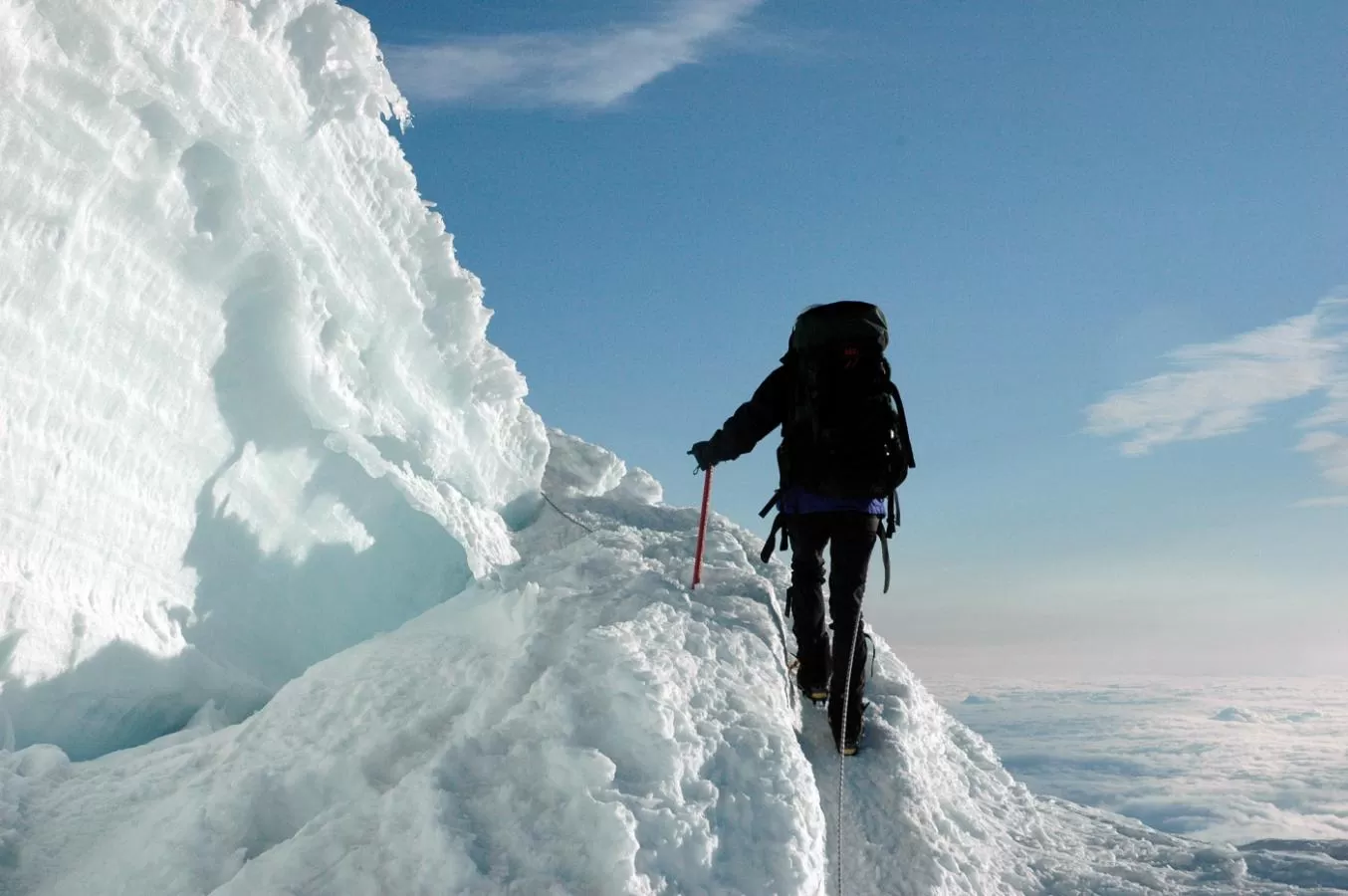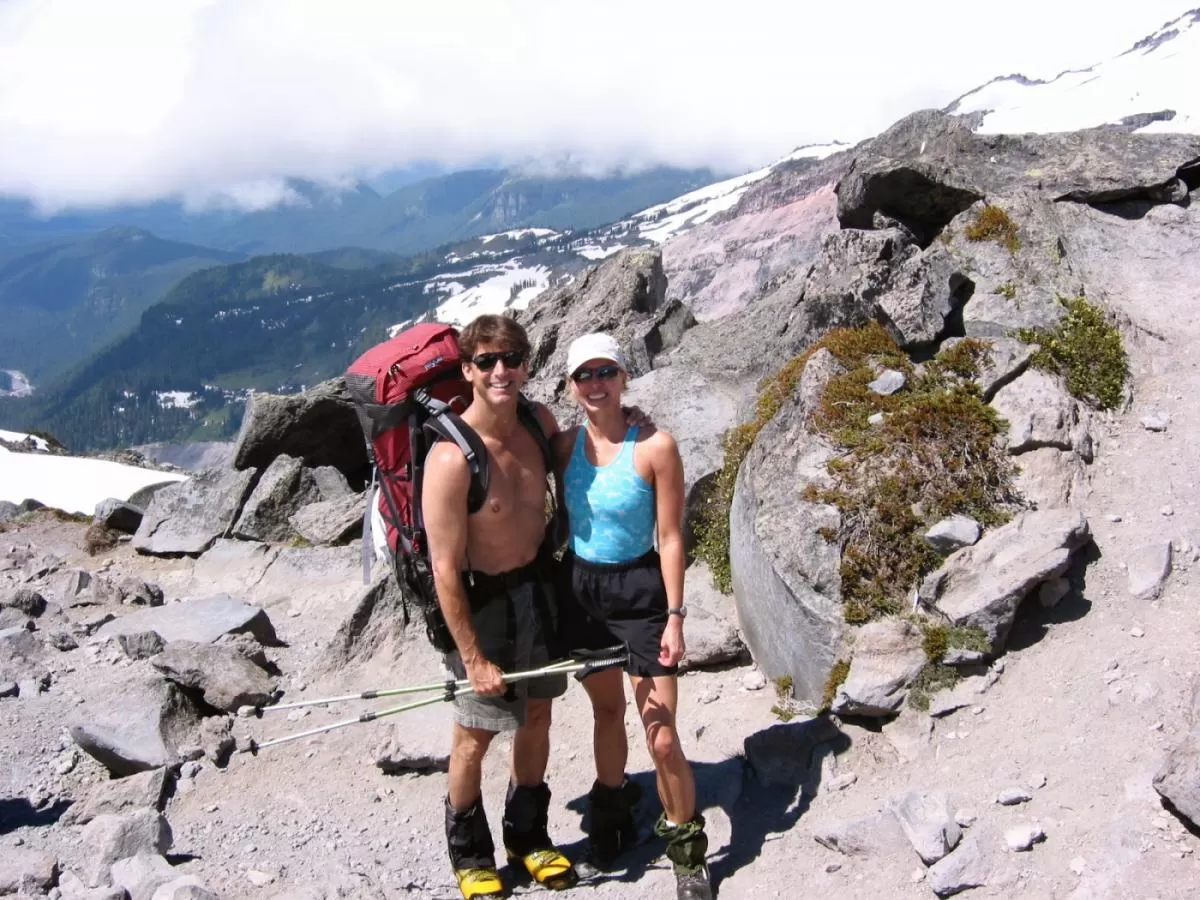Last Minute Tips Before Your Mountain Climb
Published: 07/30/2018

Me crossing an ice bridge on Mt. Rainier with an impressive crevasse to my left.
Getting ready to go climb your mountain? I have some tips for you gathered from myself and all the climbers and mountaineers that I have known over the years.
Maria Faires, RD is a mountaineering fitness and nutrition expert.
First, start by learning about acute mountain sickness and prevention tips. AMS is unlikey to be a big issue on mountaineeriing trips that are less than 5 day trips but if you are going to climb, you need to educate yourself about it.
The week before your climb, get extra rest, decrease your hard workouts, and hydrate well. Hydration For Sports Performance. The week before the climb, do not consume alcohol until after your climb.
Rest is important, but so is maintenance of your fitness. This is the period to taper your training plan, getting a balance somewhere in between the two extremes. Volume should be reduced during the taper period. Research recommends that training volume be reduced by 50-70 percent for endurance athletes. Frequency of workouts can also be reduced to lessen the training fatigue. If you have been doing multiple workouts a day, switch to a single workout per day. This final week is also a good time to focus on stretching and recovery for your body. Take special care with your nutrition, recovery routine, and sleep habits to allow your body to rest from all the hard training you have been doing the last few months.
Start packing today! At least 2 weeks before. Do not procrastinate. That can lead to anxiety and you want to feel calm and ready to go the week prior to your climb. Pack what you need but pack as lightly as you can. For instance, a dab of toothpaste in a plastic bag with your toothbrush rather than the whole travel tube. Too heavy of a pack going up to base camp can wipe you out.
Pack your food. I have a whole blog post dedicated to Mountaineering Food Ideas.
Are you fueling your body optimally? See my tips for fueling for performance here.
Have you been doing stair climbing for moutaineering?
Check out all my mountaineering resources.
Is it going to be really hot during your climb. Check out my tips for mountaineering in the heat.
Need a glacier hike pack list? go here.
During Your Climb
Pressure breathe often after you leave base camp. This will help replenish ATP, the energy molecule you need, and help prevent getting nauseous.
On your climb, keep your pace slow and steady. One foot in front of the other.
Be your own motivational coach. "I have trained hard for this I can do it. All I have to do is keep walking one foot in front of the other. I'm ready for this. I can and will do it. You got this." Relax and breathe. Picture yourself standing on the summit. Clear your mind of all self-doubts.
Dress like your guide does. You want to maintain a comfortable and not sweaty temperature. Wear light colored clothing to reflect the heat.
Use the rest step, a lot! (Practice on Camp Muir hike or your steep glacier training hikes or even at home on your stairs as I demonstrate in this video). It will give you a momentary rest. Also utlize the kick step. View how to do the kick step and rest step here.
Also, practice pressure breathing. The pressure breath helps to improve gas exchange in the lungs by increasing the pressure in the lungs. Inhale as fully as possible, then exhale with force, while pursing the lips slightly so as to create a smaller hole, as if trying to blow out a large amount of birthday candles. The pressure breath helps to combat the effects caused by decreasing atmospheric pressure as climbers gain altitude.
Before your breaks have a plan for what you need to do at your break because your breaks are short: drink, eat, adjust clothing, reapply sunscreen, go to the bathroom, take an Ibuprofen, etc. Keep ibuprofen handy to take in a little container in your lunch and snack kit. Take extra to offer to your friends.
Focus on the moment and the technical aspects. Ice ax in uphill hand, rest step, pressure breathe. And enjoy the experience!
Eat and drink at every break even if you don't feel like it. Drink often! You will feel your respiration rate going up and your body will lose water much faster than it would at sea level – even if you are not physically active. This is why drinking water at high altitude is so important. When your body is working harder, and you are breathing harder, your body will also use up more water. You can add powdered Gatorade or Cytomax to your water. Hopefully you have packed easy to open, easy to eat snacked easily accessible in your pack and pockets.
Repeat to yourself what Lou Whittaker said to me: "Do your best and you're going to make your own summit. You're going to be higher than anyone in the state." ~Lou Whittaker."We learn so much about ourselves, our bodies, our mind." To view him speaking to our Mt. Rainier climb school go here. (In case you don't know Lou, he led the first American ascent of the North Col of Mount Everest in 1984. Lou founded RMI Expeditions.)
Focus on one step at a time. Peter Whittaker (Lou Whittaker's son) said to me once, "just put one step in front of another until there ain't no more."

Maria Faires, RD and mountaineer and RMI guide Peter Whittaker
Ask for support from your guide if you need it. Offer support and encouragement to your teammates.
Focus on your breathing and heart rate. Get into a pace and you'll start climbing like a machine. Play music in your mind and keep the beat going on.
You will feel physical discomfort. This isn't necessarily a "warning alarm". Discern what is danger pain and what is just plain discomfort. Do you need to slow down, take off a layer, pressure breathe or rest step more, drink or eat more or calm your mind?
Feeling afraid? It is normal to feel fear when in some of the dangerous conditions on the upper mountain. But allowing the fear to overtake you can be dangerous. Here is a short video on how to deal with the fear of falling.
The amygdala is a structure in the temporal lobe of your brain that is responsible for the flight or fight response when your brain senses danger. When we perceive a threat, the amygdala sounds an alarm. A series of events triggers the release of adrenaline and other stress hormones which leads to increased breathing, higher blood pressure and a racing heart, shaking and sweating. This is called 'the amygdala hijack'. This response makes it hard to think clearly and can make you more prone to an accident. Not a good scenario on the upper mountain.
You can calm the amygdala by practicing mindfulness. Choose something in the environment and focus on it. Don't let the mind race, slow down and pay attention.
You can also calm the amygdala by breathing. Take some nice slow breaths. This helps stop the production of the stress hormones. Practice the in-breath and out-breath repeatedly at the same intervals. Inhale, counting 1, 2, 3, and 4 then exhale 1, 2, 3, and 4.
You can also calm the amygdala by talking to yourself in a reassuring way. What would you say to a friend to calm them down?
I asked my client Dan Akerman (who I have coached for the last 7 years on all his climbs including Mt. Everest, all them successful!!) to share his thoughts on fear on the mountain and he said, "Slow it down, one foot in front of the other, stay focused on what you are doing, not the fear." He also warned that "one needs to be just as focused on the way down. The goal isn't to just reach the summit but to get safely back home. Be cognizant on the way down, focus and watch your steps. 80% of accidents happen on the descent."
Good luck and enjoy your journey!
Categories: Hiking and Mountaineering
Tags: #sportsnutrition
Active Nutrition is a participant in the Amazon Associates Program, an affiliate advertising program designed to provide a way for websites to earn advertising revenues by advertising and linking to Amazon. If you click on one of my recommended item links and then place an order through Amazon, I receive a small commission on that sale, at no extra expense to you of course. This is a way to support me and my work every time you shop at no cost to you.





